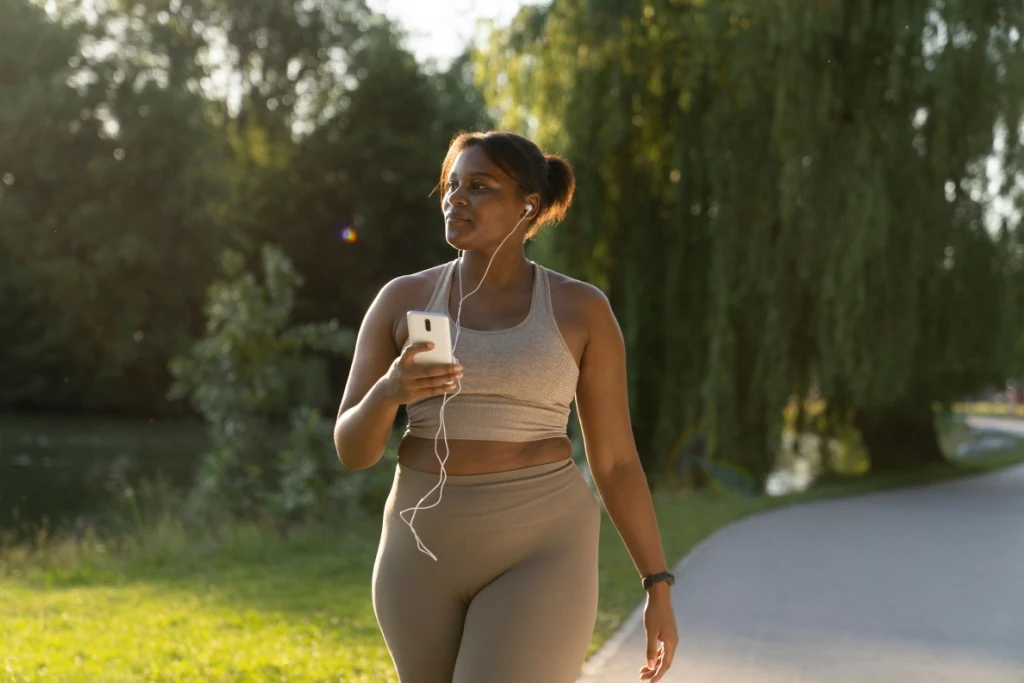How To Break Your Bad Habits (And Make Good Ones A Reality)
It might feel like an impossible task, but breaking your worst habits can be done.

January 31, 2025 - Updated January 31, 2025

Cancelling your workout at the last minute. Biting your nails. Always pressing snooze and waking up feeling even groggier. Spending a little too much time on your phone doomscrolling. We all have bad habits that we know aren’t helping us make progress on our fitness and wellbeing goals, and yet, breaking them just isn’t as simple as recognising the behaviours that aren’t serving us.
A 2019 paper published in Biol Psychiatry exploring the science behind habitual and purposeful behavior found habits are triggered in response to contextual cues we associate with the action. Think about those daily tasks you do without even thinking about it, like washing your hands after using the bathroom or putting on your seatbelt after getting into the car. These are all habits that are triggered by a cue.
While washing your hands and wearing a seatbelt definitely aren’t habits we want to break, what about those actions that come naturally to us but are actually doing us a major disservice? We know old habits die hard, but you can retrain your brain to ditch those negative behaviours and develop healthy habits that will truly stick. Here are seven tried and tested ways to make your bad habits a thing of the past - for good.
Identify your triggers
James Clear, author of the New York Times bestselling book Atomic Habits (which happens to be a favourite of Sweat trainer Britany Williams) breaks the process of building a habit down into four steps: cue, craving, response and reward. Clear goes on to explain that there are five key ways a habit can be triggered: time, location, preceding event, emotional state and those around you.
Clear says that when it comes to bad habits, taking stock of how you feel at these key moments can help you better identify your triggers. For example, if you constantly find yourself eyeing up the snack drawer at 3pm, this might have more to do with mid-afternoon boredom than genuine hunger. Similarly, if you’re at a particular location (such as the pub) on a Thursday afternoon, you might find yourself drinking more heavily than you would in a different environment.
Knowing what comes before the bad habit can help you break unwanted behaviours and cement new habits by creating new habit loops.

Embrace the discomfort
Even the habits we want to break often feel good in the moment due to the release of dopamine in the brain. According to Harvard Health, this happens anytime you do something that helps our species survive, like having sex or eating food. Sadly, the brain isn’t able to differentiate between what’s good or bad for us here (even though we know having sex with the wrong person won’t make us feel our best the next day and a whole block of chocolate probably won’t feel that great in an hour's time).
If steering clear of a bad habit once makes you feel the opposite of empowered, know that you’re not alone. The National Institute of Health highlights that willpower is like a muscle, and can leave you feeling drained after first use but strong and empowered with repeated practice.
We recommend sitting with the discomfort that comes hand in hand with breaking bad habits and sticking with it. It won’t always be an easy road and there will be ups and downs, but it will be worth it and it will get easier.
Come up with a game plan
Understanding the cues that trigger your worst habits and knowing embracing the challenge ahead is only one part of putting them to bed. To really solidify healthier habits and ditch bad ones, you’ll want to put a plan in place to disrupt and replace your cues. The Mayo Clinic cautions against adopting an all-or-nothing approach here. After all, getting from A to B isn’t always a straight line and good things take time.
Instead, work on keeping it simple with a focus on disrupting your cues. If we go back to the example of constantly snoozing your alarm clock in the morning instead of getting out of bed when it first goes off, try disrupting your normal flow of cues and behaviour by putting your alarm on the other side of the room so you’ll have to get out of bed to turn it off.
Replacing bad behaviours is also a great way to rewire your neural pathways. Always pick up your phone as soon as you’ve woken up? Why not put your phone out of reach and opt for a book instead.
Try habit stacking
This can be a great way to make good habits part of your regular routine while saying goodbye to bad ones. Habit stacking is all about setting yourself up for success by stacking a new habit on top of an existing behaviour, helping to make new habits a seamless part of your routine with minimal effort.
Think about the actions you take every day without thinking about it and stack a positive new behaviour on top of this action - this is particularly powerful when it’s replacing a previous behaviour you’re trying to ditch.
Here are some examples of some new habit stacks:
If you normally reach for your phone to scroll TikTok after your lunch break, try to stack a 15-minute walk around the block on top of your lunch instead.
Replace looking for a quick snack between meetings with a 5-minute exercise snack as soon as your meeting ends.
If you normally get home from work and sit down on the couch, try to walk in the door and put on your activewear straight away or choose your workout fit for the next day if you prefer to move in the mornings!

Use the three Ps
If you find yourself constantly bailing on your workout at the last minute or you just can’t find the motivation to pick a new Sweat program, you might need to change how you’re going about your routine. Doctor turned productivity expert Ali Abdaal caught up with Kayla Itsines on the Sweat Daily to talk about his go-to hack to make anything you do more enjoyable (and more likely to stick). According to Abdaal, it all comes down to the three Ps: Play, Power and People.
These three guiding principles are all about making the process of solidifying new behaviours or already engrained parts of your routine more fun.
“Incorporating any of these into anything you’re doing that you find hard - whether it’s your work, your gym session or anything else - is guaranteed to make it a little more fun,” says Abdaal.
So how does it work when it comes to ditching those bad habits? Let’s take the example of constantly cancelling your Sweat sessions…
Play: why not ditch your regular workouts (even just for a week!) and opt for a different training style you enjoy or try something totally new to spice things up
Power: focus on the style of training that makes you feel your most powerful or set yourself small, achievable goals so you can feel a regular sense of achievement
People: cancelling on yourself is easy, but cancelling on a friend? Nobody wants to be that person. Try planning your next session with a workout buddy and reap the rewards of exercising with others.
Track your progress
Now that you know what habits you want to ditch and which ones you want to make stick, it’s time to set yourself up for ongoing success. Sweat’s habit tracker is a simple but oh, so effective way to put your new habits down on paper and keep yourself on track. You can use it to write down the habits you want to change or solidify (for example, if screentime is an issue for you, your new habit might be keeping it below an hour a day or not using a certain app that you always turn to in moments of boredom) and use our tracker as a visual reminder for just how far you’ve come.
Reward yourself
As with any health or fitness goal, finding a way to celebrate the milestones on your journey can help you stay the course. Cleveland Clinic highlights that incentivising yourself can be a great way to reinforce positive behaviour and keep you on track. For example, if the bad habit you want to break is spending money on takeaway when you could be opting for home-cooked meals, put the money you normally spend on food delivery and put it in a jar. Once you hit a certain amount, reward yourself with a special treat that wouldn’t have been possible if takeout was still a part of your routine.
Make fitness a habit with Sweat
Turning your health and fitness goals into habits is simple with the Sweat app. With 60+ programs and thousands of workouts to choose from, the Sweat app is loaded with features designed to help you make fitness a habit, level up your progress and supercharge your fitness journey, one day at a time.

Amy is a writer and editor at Sweat. She has over a decade of experience in women’s publishing and digital media and has previously worked across titles including Mamamia, Grazia and Cosmopolitan.
* Disclaimer: This blog post is not intended to replace the advice of a medical professional. The above information should not be used to diagnose, treat, or prevent any disease or medical condition. Please consult your doctor before making any changes to your diet, sleep methods, daily activity, or fitness routine. Sweat assumes no responsibility for any personal injury or damage sustained by any recommendations, opinions, or advice given in this article.
Wellbeing